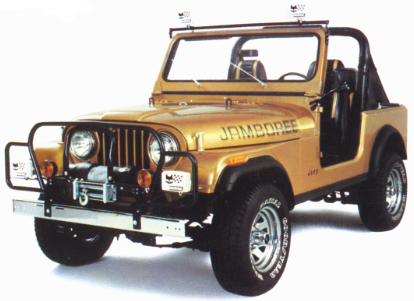
The Rarest CJ-7 Ever Built

 |
1982 Jeep CJ-7 Jamboree The Rarest CJ-7 Ever Built  |
| Main | Jambo Registry(TM) | Production | The Jambo | History |
| Parts for Sale | Documents | FAQs | Fun | About |
|
|
CJ VIN plates have several data fields. The
upper left field is known as the Zone Order Number (ZON). In the example
on the left, the ZON is J100965. What does this numbering mean? We have searched for what these numbers mean, but have not been able to turn up anything. We have been told by a few guys that these numbers don't mean anything. They were just the number attached to the Jeep when it was ordered and cannot be related to anything else. As we detail below, we are not sure this is correct. |
Jeep divided the US into zones for ordering purposes. When you ordered a Jeep, the dealer would transmit that order to the zone office. The zone office would compile orders from multiple dealers and transmit them to the factory for production. Thus far, we have been unable to find a zone list for Jeep. However, the pictures below show AMC zones during the 1970s and 1980s. The 1980s chart shows the process by which AMC car orders were compiled by zones and sent to the plant.
The 1970s chart shows that AMC divided the US into 23 zones. The 1980s chart shows 14 zones. The 80s chart also shows that zones were assigned a two-digit number. For example, the Los Angeles zone office was number 30. We don't think Jeep likely used the same zones or zone numbers as AMC. Also, the numbering likely changed over the years.
AMC Zones in 1970s
AMC Zones in 1980s
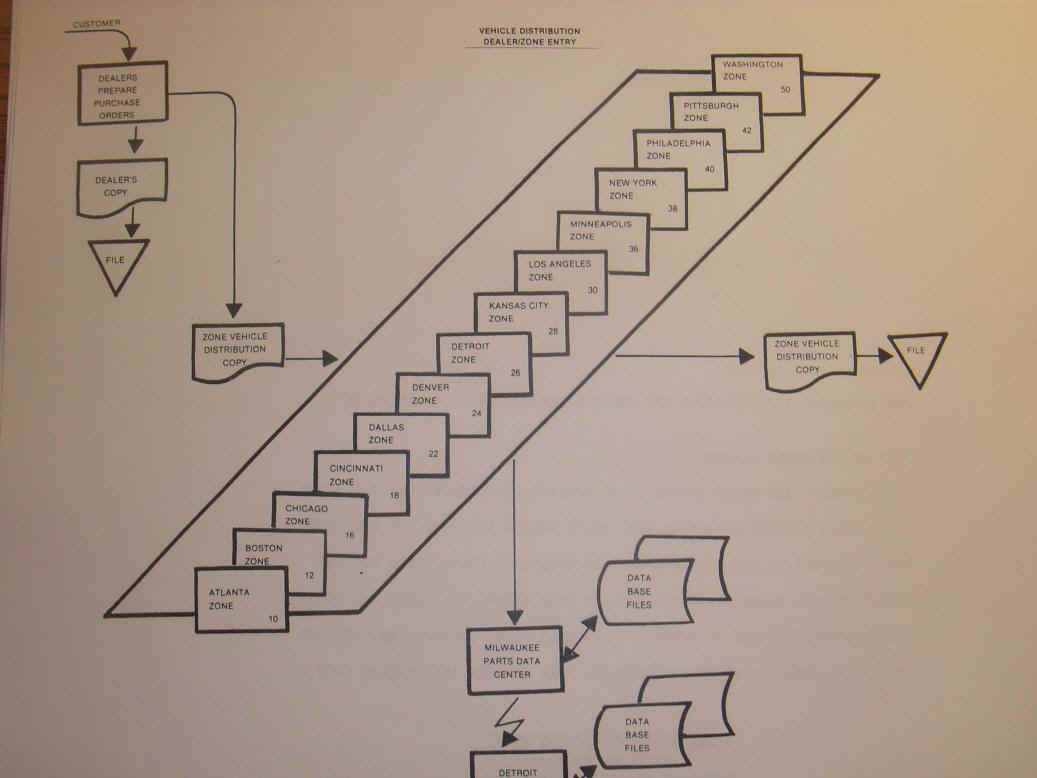
In addition to the VIN tag, the ZON also appears on Jeep window stickers. For example, in the window sticker below, the ZON is J156134. The numbers proceeding this are the Zone (25) and the dealer number (5508).
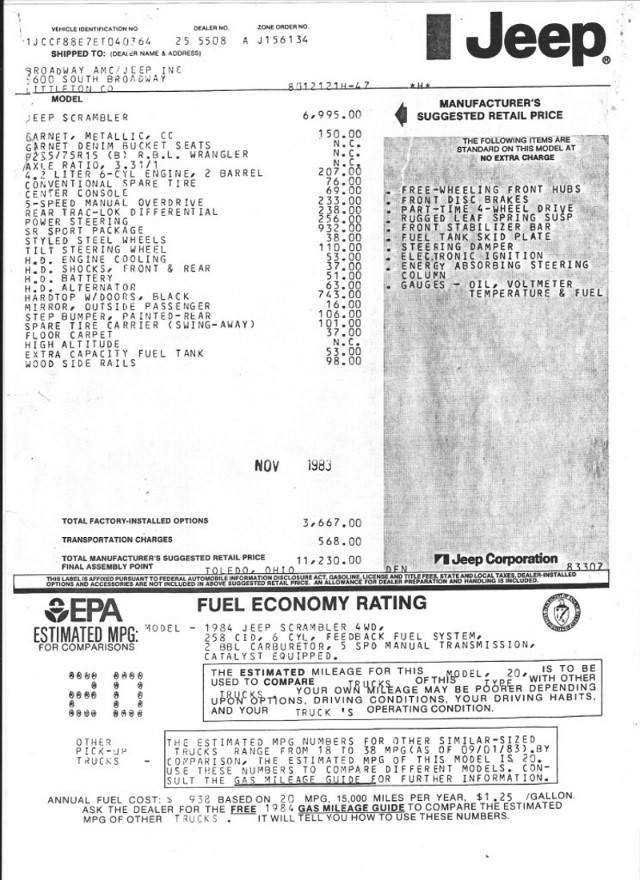
We have been trying to figure this out for a long time. We have been told that it was simply a number assigned to orders as they came in and can't be related to anything. We don't think this is correct--at least for Jambos. Below, we detail what we know and don't know about zone order numbers (ZONs).
The first clue that the ZON might have some coding to it is the fact that it is six digits long. That would allow for 999,999 orders. Jeep never produced anywhere near that number of vehicles in a single year. It is also clear that the ZON was not a cumulative count of the number of vehicles ordered over AMC's life because 1982 Jambo ZONs start around 100000 (Jeep sold over 200,000 vehicles in 1979 alone) and ZON's from earlier years, such as 1979, often start with 5 or even 9.
The second clue is the name: Zone Order Number. This sounds like the order number was assigned to or by the zone as they placed orders. This would seem to make sense. When the dealer sent an order to the zone the zone assigned it an order number. If Jeep had multiple zones how would they avoid duplicate order numbers? We don't think they would have allowed duplicate order numbers because dealers had to send in the VIN and the ZON when ordering parts because the ZON was tied to non-standard parts that might have been used. For example, if you upgraded to 3.31 gears, Jeep tracked that with the ZON.
So, it seems likely that the ZON has a coding to it. What could that coding mean?
Below is a plot of Sequential Serial Numbers (last six digits from the VIN) vs ZONs for the G-2 group of Jambos. This was the largest batch of Jambos built. We believe these Jambos were built on spec and sent out to the dealers for sales--that is, they were not special orders placed by individuals. For more, see our Production page.
The relationship between these two numbers is nearly perfect: given a ZON you can almost specify the sequential serial number (SSN) or the production number of the Jambo, and vice versa. For example, a ZON number of 130000 should have a SSN around 0.0045*130000 + 41425 = 42010. This means that the ZON does have a serial coding to it. Jambos with higher order numbers tended to be built after Jambos with lower order numbers.
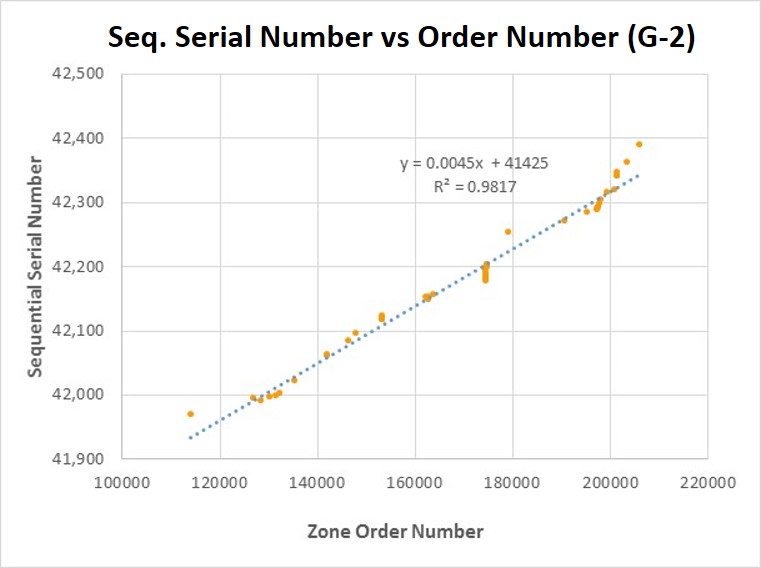
Also, notice that the ZONs in this sample run from around 110000 to 206000, which is a range of almost 100,000, even though only about 400 vehicles were produced during this time. Clearly, the ZON is not only a sequential order number.
We also notice that the ZONs seem to be spread out rather evenly over this range. Why would that be? What was Jeep trying to "spread out" during the production of the G-2 Jambos? We think they were allocating the production of Jambos across their dealer network, which is itself, spread out across the US. Therefore, the ZON must have a geographic coding in it.
So, there seems to be a geographic coding in the ZON, but how does it work? Remember that Jeep used a two digit number to represent the zone. This suggests that the ZON might also have a two digit number in it that specifies where the order was placed.
We suspect the system works as follows:
1st digit. Specifies the country for the zone office that took the order. We believe 1-6 signify the USA and 7-9 are Canada. Jeep used this same geographic coding to denote plant assembly location in VINs. For example, all 1979 Silver Anniversary CJ-5s have a leading 8 in their SSN because they were made at Jeep's Brampton plant in Canada. We don't know how export was handled. Perhaps overseas dealers transmitted their orders to a zone in the US and would have been given a US ZON. We also think this number served a serial purpose, as we describe below.
2nd-3rd digit. Specifies the area where the dealer that placed the order is located. We believe these were unique numbers that further divided the country. That is, they were not the zone numbers, but another two digit number that specified a smaller geographic area. Jeep zones likely covered large geographic areas, as AMC zones did. Jeep had another process for shipping vehicles that involved sending them to particular rail lines. In this case, Jeep might have used a number to get the vehicle to an area that contained fewer dealers than an entire zone. For example, for AMC, the Boston Zone covered the entire Northeast, except Connecticut.
4th-6th digit. A sequential order number that was assigned by the zone as it processed orders. Because only three numbers are used, Jeep would only be able to assign 999 unique numbers. This is where the 1st digit comes in. We believe it was also used to serialize the orders as the leading digit. This would have meant that Jeep could assign 9999 unique numbers per area. We think the model year started with 1xx000, where xx is the area. Once that area reached 1xx999, they would rollover to 2xx000.
In sum, digits 1 and 4-6 are serial order numbers and digits 2-3 are a geographic coding denoting the area where the Jeep was to be shipped. Once the Jeeps arrived in the area, trucks would then distribute them to the specific dealers.
The theory laid out above is based on analyzing Jambo order numbers and a lot of tinkering. It could be wrong, but there seems to be some strong evidence to support it. Below we provide some examples.
The data below presents the SSN, ZON, and the location for Jambos with area numbers 00 through 09. The locations highlighted in red represent cases where we know where that Jambo was originally sold. For example, we know that 66,255 with order number 100050 was originally sold in CA. Areas highlighted in yellow denote the state where we strongly suspect the Jambo was originally sold. For example, we believe 42,319 was also sold in CA. The locations that are not highlighted are the cases where we don't know where the Jambo was originally sold. In that case, we list the state where it is currently located, the idea being that Jeeps are large objects and while they could have moved in 35 years, they tend to stay around the region where they were originally sold.
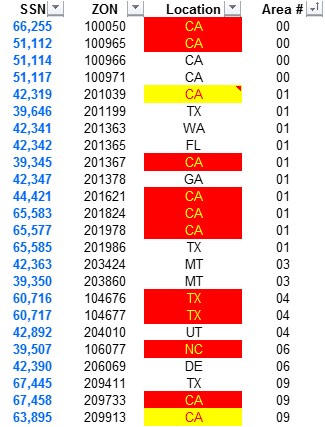
This list is very interseting:
Every Jambo that we list as being originally sold in Area 00, according to our ZON theory, was either originally sold in CA or is currently in CA.
In the case of Area 01, 4 of the 10 Jambos listed were originally sold in CA and another is very likely to have been sold there. Of the remaining Jambos with Area 01, 2 are currently in TX and 1 is in WA--neither of which is terribly far from CA. The other 2 are in FL and GA.
Both of the Jambos with Area 03 are in MT.
2 of the 3 Jambos with Area 04 were originally sold in TX. The third is in UT, which is not far away.
The lowest number areas are in CA. Perhaps this make some sense as Jeep started numbering on the West Coast, or the West Coast was a major (the most important?) sales area.
Another interesting case is Aera 74, which is shown below. Of the 8 Jambos with Area 74, 2 were originally sold in Nebraska (NE). 5 of the remaining 6 are in the midwest and the 8th is in Alaska. So, 7 our of 8 Jambos with Area 74 were either originally sold in NE or are in a nearby state.
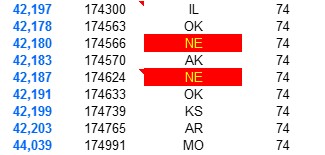
Here is another interesting case, Areas 38-48:
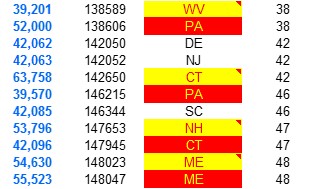
All of these Jambos are on or near the East Coast.
Of the two Jambos with Area 38, one was sold in PA and the other was likely sold in WV. Perhaps Area 38 covered the Pittsburgh/Morgantown area.
Area 47 seems to have covered NH and CT.
Maine was 48.
Areas 47-48 were in the Northeast.
This discussion above focused on the G Group. This is the group of Jambos that we believe Jeep produced on spec and sent to the dealers. In this case, it seems likely that orders were placed at the corporate office and then produced shortly thereafter. We also believe that this group of Jambos closely, if not exactly, followed the original Jambo specifications. These Jambos were batch built and there is a very close relationship between the order number and the VIN (see above).
The M group appears to be the Jambos that were ordered by individual buyers. This is when the White Jambos were produced and Jeep also allowed automatic transmissions. In this case, the Jambos were made in much smaller groups or as one-offs. You can see this on our Production page. Below is a plot of sequential serial number vs order number for the M Group.
There are many M-Group Jambos with order numbers in the same range as the G-Group, but with later SSN. We believe this makes sense because these were Jambos that were ordered by individuals. The individual likely saw the Jambo advertising and went into the dealer to buy one. If the dealer did not have one in stock or they wanted something special, like AC or an automatic transmission, they had to wait a couple of months. The order was entered into the system, but production occured later.
There is also a larger clustering of Jambos with both higher ZONs and high SSNs. These Jambo were ordered near the end of the model year and produced at the end of the model year.
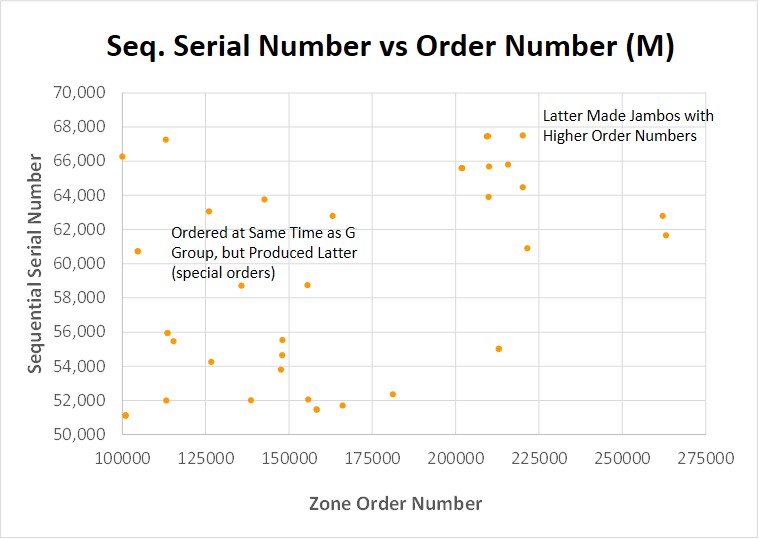
Our theory could be wrong. Or, it might only apply to 1982 CJs. Or, it might have been some kind of a coincidence that only applied to the Jambos, though that seems very unlikely.
With that caveat, our best estimate for how to decode your Zone Order Number is below. The second and third digit of your Zone Order Number denote the area where your Jambo was sold. You can use the table below to decode these digits. We also include our level of certainty with our estimate (Likely > Probable > Possible). A "-" indicates that we don't have solid data on this area.
| Area Number | Location | Certainty |
| 00 | California | Likely |
| 01 | California | Likely |
| 03 | Montana | Possible |
| 04 | Texas | Likely |
| 06 | North Carolina | Probable |
| 09 | California | Likely |
| 10 | - | - |
| 12 | Southwest USA | Possible |
| 13 | Arizona-Utah | Probable |
| 14 | Colorado | Probable |
| 15 | Maine | Possible |
| 20 | Texas | Possible |
| 21 | Wyoming | Possible |
| 26 | California | Probable |
| 28 | California | Probable |
| 30 | - | - |
| 32 | - | - |
| 34 | - | - |
| 35 | New Mexico-Texas | Possible |
| 38 | Pennsylvania | Probable |
| 42 | Connecticut-New Jersey-Delaware | Possible |
| 46 | Pennsylvania | Possible |
| 47 | Connecticut-New Hampshire | Possible |
| 48 | Maine | Probable |
| 51 | Western USA | Possible |
| 52 | Colorado | Possible |
| 53 | Colorado-New Mexico | Probable |
| 55 | North Carolina | Possible |
| 58 | Virginia | Possible |
| 62 | - | - |
| 63 | - | - |
| 66 | - | - |
| 69 | Illinois | Possible |
| 74 | Midwest USA | Probable |
| 77 | - | - |
| 79 | - | - |
| 80 | - | - |
| 81 | Illinois | Possible |
| 90 | - | - |
| 95 | - | - |
| 97-99 | Special Orders | Possible |
Note: The above list is not exhaustive. It only includes the area numbers that we have observed on Jambos.
|
© Copyright 2018. J. Eric Bickel. All rights reserved The Jambo Registry is a trademark of www.82jambo.com. UA-83787031-1 |